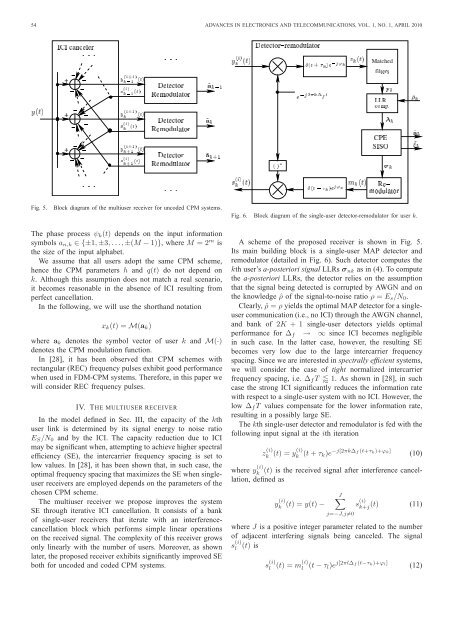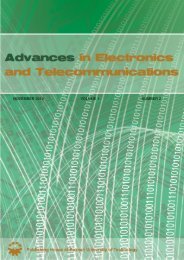channel - Advances in Electronics and Telecommunications
channel - Advances in Electronics and Telecommunications
channel - Advances in Electronics and Telecommunications
Create successful ePaper yourself
Turn your PDF publications into a flip-book with our unique Google optimized e-Paper software.
54 ADVANCES IN ELECTRONICS AND TELECOMMUNICATIONS, VOL. 1, NO. 1, APRIL 2010<br />
Fig. 5. Block diagram of the multiuser receiver for uncoded CPM systems.<br />
The phase process ψk(t) depends on the <strong>in</strong>put <strong>in</strong>formation<br />
symbols an,k ∈ {±1, ±3, . . . , ±(M − 1)}, where M = 2 m is<br />
the size of the <strong>in</strong>put alphabet.<br />
We assume that all users adopt the same CPM scheme,<br />
hence the CPM parameters h <strong>and</strong> q(t) do not depend on<br />
k. Although this assumption does not match a real scenario,<br />
it becomes reasonable <strong>in</strong> the absence of ICI result<strong>in</strong>g from<br />
perfect cancellation.<br />
In the follow<strong>in</strong>g, we will use the shorth<strong>and</strong> notation<br />
xk(t) = M(ak)<br />
where ak denotes the symbol vector of user k <strong>and</strong> M(·)<br />
denotes the CPM modulation function.<br />
In [28], it has been observed that CPM schemes with<br />
rectangular (REC) frequency pulses exhibit good performance<br />
when used <strong>in</strong> FDM-CPM systems. Therefore, <strong>in</strong> this paper we<br />
will consider REC frequency pulses.<br />
IV. THE MULTIUSER RECEIVER<br />
In the model def<strong>in</strong>ed <strong>in</strong> Sec. III, the capacity of the kth<br />
user l<strong>in</strong>k is determ<strong>in</strong>ed by its signal energy to noise ratio<br />
ES/N0 <strong>and</strong> by the ICI. The capacity reduction due to ICI<br />
may be significant when, attempt<strong>in</strong>g to achieve higher spectral<br />
efficiency (SE), the <strong>in</strong>tercarrier frequency spac<strong>in</strong>g is set to<br />
low values. In [28], it has been shown that, <strong>in</strong> such case, the<br />
optimal frequency spac<strong>in</strong>g that maximizes the SE when s<strong>in</strong>gleuser<br />
receivers are employed depends on the parameters of the<br />
chosen CPM scheme.<br />
The multiuser receiver we propose improves the system<br />
SE through iterative ICI cancellation. It consists of a bank<br />
of s<strong>in</strong>gle-user receivers that iterate with an <strong>in</strong>terferencecancellation<br />
block which performs simple l<strong>in</strong>ear operations<br />
on the received signal. The complexity of this receiver grows<br />
only l<strong>in</strong>early with the number of users. Moreover, as shown<br />
later, the proposed receiver exhibits significantly improved SE<br />
both for uncoded <strong>and</strong> coded CPM systems.<br />
Fig. 6. Block diagram of the s<strong>in</strong>gle-user detector-remodulator for user k.<br />
A scheme of the proposed receiver is shown <strong>in</strong> Fig. 5.<br />
Its ma<strong>in</strong> build<strong>in</strong>g block is a s<strong>in</strong>gle-user MAP detector <strong>and</strong><br />
remodulator (detailed <strong>in</strong> Fig. 6). Such detector computes the<br />
kth user’s a-posteriori signal LLRs σnk as <strong>in</strong> (4). To compute<br />
the a-posteriori LLRs, the detector relies on the assumption<br />
that the signal be<strong>in</strong>g detected is corrupted by AWGN <strong>and</strong> on<br />
the knowledge ˆρ of the signal-to-noise ratio ρ = Es/N0.<br />
Clearly, ˆρ = ρ yields the optimal MAP detector for a s<strong>in</strong>gleuser<br />
communication (i.e., no ICI) through the AWGN <strong>channel</strong>,<br />
<strong>and</strong> bank of 2K + 1 s<strong>in</strong>gle-user detectors yields optimal<br />
performance for ∆f → ∞ s<strong>in</strong>ce ICI becomes negligible<br />
<strong>in</strong> such case. In the latter case, however, the result<strong>in</strong>g SE<br />
becomes very low due to the large <strong>in</strong>tercarrier frequency<br />
spac<strong>in</strong>g. S<strong>in</strong>ce we are <strong>in</strong>terested <strong>in</strong> spectrally efficient systems,<br />
we will consider the case of tight normalized <strong>in</strong>tercarrier<br />
frequency spac<strong>in</strong>g, i.e. ∆f T � 1. As shown <strong>in</strong> [28], <strong>in</strong> such<br />
case the strong ICI significantly reduces the <strong>in</strong>formation rate<br />
with respect to a s<strong>in</strong>gle-user system with no ICI. However, the<br />
low ∆f T values compensate for the lower <strong>in</strong>formation rate,<br />
result<strong>in</strong>g <strong>in</strong> a possibly large SE.<br />
The kth s<strong>in</strong>gle-user detector <strong>and</strong> remodulator is fed with the<br />
follow<strong>in</strong>g <strong>in</strong>put signal at the ith iteration<br />
z (i)<br />
k (t) = y(i)<br />
k (t + τk)e −j[2πk∆f (t+τk)+ϕk]<br />
(10)<br />
where y (i)<br />
k (t) is the received signal after <strong>in</strong>terference cancellation,<br />
def<strong>in</strong>ed as<br />
y (i)<br />
k<br />
(t) = y(t) −<br />
J�<br />
j=−J,j�=0<br />
s (i)<br />
k+j (t) (11)<br />
where J is a positive <strong>in</strong>teger parameter related to the number<br />
of adjacent <strong>in</strong>terfer<strong>in</strong>g signals be<strong>in</strong>g canceled. The signal<br />
(t) is<br />
s (i)<br />
l<br />
s (i)<br />
l (t) = m(i)<br />
l (t − τl)e j[2πl∆f (t−τk)+ϕl]<br />
(12)







